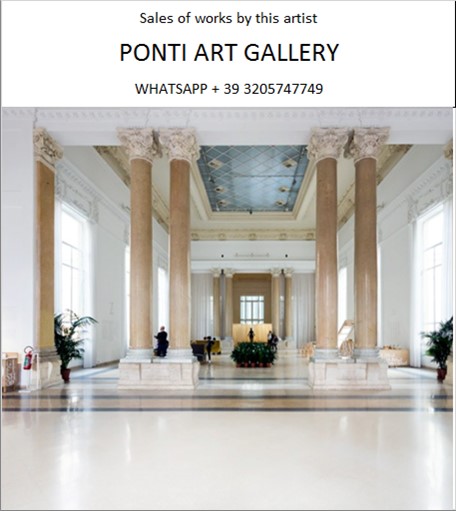Ponti Art Gallery is interested in buying and selling works
of art by this artist.

Emilio Scanavino Biography
Emilio Scanavino was born on February 28, 1922, in Genoa, Italy, into a family with a rich cultural and intellectual background. His father, Attilio Scanavino, was an accountant and belonged to a family of merchants who had lived for two generations in Salto Oriental, Uruguay, before returning to Italy during the Spanish flu pandemic of 1918. Attilio, who had volunteered to fight in World War I, married Maria Felicina Sterla upon his return. He worked as an importer of coffee from Brazil but had a keen interest in philosophy and esotericism, amassing a collection of books in Portuguese, Spanish, and Italian. This intellectual environment played a significant role in shaping Emilio's early life and interests.
During his childhood, due to his father's political persecution, Emilio was confined to playing on the terrace of his home, where he spent his days building knick-knacks and small paper toys. He also developed a passion for collecting precious racing pigeons, a hobby he pursued into adulthood. Despite his father's wishes for him to embark on a more conventional career path, Emilio's artistic talents were undeniable. In 1938, after convincing his father to allow him to pursue his passion, he enrolled at the Art High School in Genoa, where his artistic abilities and aptitude flourished. This period marked the beginning of his lifelong engagement with the arts, drawing inspiration from literature and poetry by notable writers such as Guillaume Apollinaire, André Gide, and Franz Kafka, among others.
Scanavino's formal education in the arts continued as he graduated from the Art High School in 1942, the same year he held his first solo exhibition in Genoa. His early exposure to the art world was further enriched by his studies in Architecture at the University of Milan, although his education was interrupted by military service. After the war, in 1947, Scanavino moved to Paris, where he immersed himself in the vibrant artistic community, meeting poets and artists who would influence his work significantly. This period was crucial for his development as an artist, as he engaged with Cubism and began to formulate his unique artistic language.
By the 1950s, Scanavino had become a prominent figure in the Italian art scene, known for his distinctive style that both connected to and diverged from the informal art movement. His work was characterized by a highly personal style that earned him international recognition. He was a regular participant at the Venice Biennale during the 1950s and was honored with a personal room in 1960. His achievements were further acknowledged when he won the Pinin Farina Award in 1966. Scanavino's work was exhibited in leading Italian galleries and internationally in cities such as London, Paris, and Philadelphia. His contributions to the art world were celebrated through major anthologies and retrospectives, notably at the Darmstadt Kunsthalle, Palazzo Grassi in Venice, and Palazzo Reale in Milan.
Throughout his career, Scanavino explored various mediums, including painting, sculpture, and ceramics. His work in ceramics began in the early 1950s, in Tullio Mazzotti's studio in Albissola Marina, showcasing his versatility and willingness to experiment with different forms of artistic expression. Despite facing health challenges later in life, Scanavino continued to work and exhibit extensively, supported by his friend Mario Valente. His dedication to his art remained unwavering until his death in Milan on November 28, 1986.
Emilio Scanavino's legacy is preserved through his contributions to postwar abstract art, with his works held in major museum collections worldwide. His artistic journey reflects a deep engagement with the cultural and intellectual currents of his time, marked by a constant pursuit of personal expression and innovation.
Emilio Scanavino Quotes and
Sales of Works
Ponti Art Gallery selects and deals with paintings by the
artist. Upon request, we provide free estimates and
evaluations, communicate prices, quotations, and current
market values.
If you are interested in BUYING or SELLING works by the
artist, contact us immediately.
If you wish to sell or receive an evaluation of the
works:
Send us a frontal photo of the painting, one of the back,
and one of the signature. Also, indicate the dimensions of
the work. Inform us about the purchase origin of the work
and any kind of available documentation (purchase
receipts, certificates of authenticity, publications). One
of our operators will respond to you on the same day. We
guarantee maximum confidentiality and extreme
professionalism.
If you wish to purchase works by the painter: Contact us
and let us know your request. We will inform you about the
available works. We also offer the possibility to
subscribe to our NEWSLETTER, through which you will be
informed at the beginning of each month about the latest
acquisitions of the art gallery.
You can send us pictures of the work:
